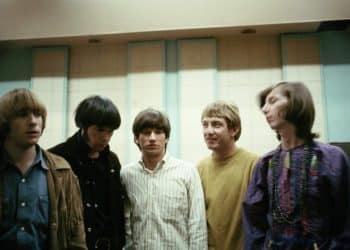Stevie Ray Vaughan, a name synonymous with electric blues guitar mastery, left an indelible mark on the music world with his raw talent, fiery performances, and soul-stirring compositions. With a career that burned brightly but all too briefly, Vaughan revitalized the blues in the 1980s, blending traditional blues with rock, jazz, and his own unmistakable style. His playing was a force of nature—passionate, emotive, and technically dazzling—and his influence continues to resonate with guitarists and music lovers around the globe.
In this article, we celebrate the legacy of this legendary artist by diving into the top 10 most popular Stevie Ray Vaughan songs of all time. These tracks are not just fan favorites; they represent the essence of Vaughan’s artistry, showcasing his searing guitar solos, soulful voice, and deep connection to the blues tradition. From electrifying anthems to heart-wrenching ballads, each song on this list is a testament to the genius of a musician who could make a single note speak volumes. Whether you’re a lifelong fan or just discovering his music, get ready to be captivated by the timeless magic of Stevie Ray Vaughan. These iconic tracks are sure to remind you why he remains a blues legend for the ages.
1. “Pride and Joy” (1983)
Stevie Ray Vaughan’s “Pride and Joy,” released on his debut album Texas Flood in 1983, quickly became one of his signature songs and a staple of the blues-rock genre. The track opens with a groovy shuffle rhythm, setting the stage for Vaughan’s exceptional guitar skills to shine through. His trademark fiery guitar licks are paired with a rhythm that’s both infectious and uplifting, making it impossible to stay still while listening. The lyrics themselves, written with a deep sense of affection, serve as a tribute to a woman Vaughan clearly holds dear. The simplicity of the song’s message—an expression of love—is elevated by the fiery emotion that Vaughan pours into his guitar solos and his smooth yet gritty vocal delivery. The track displays his ability to effortlessly merge passion with precision, a hallmark of his playing style. As Vaughan’s fingers dance across the fretboard, he mixes Texas blues influences with rock elements, creating a timeless sound that would later influence countless musicians. “Pride and Joy” not only solidified Vaughan’s reputation as a blues virtuoso but also helped introduce the world to his distinct sound and emotional depth, establishing him as one of the greatest guitarists of his generation.
2. “Texas Flood” (1983)
The title track of Stevie Ray Vaughan’s debut album Texas Flood is a heart-wrenching blues classic that showcases Vaughan’s unparalleled ability to convey raw emotion through his guitar. Originally written by Larry Davis in 1958, Vaughan’s version took the song to new heights, turning it into a defining moment of his career. The song’s anguished, soulful guitar solos cut through with a sense of desperate longing, capturing the feeling of a love lost or a heart broken. As the song builds, Vaughan’s Stratocaster wails with emotion, sending chills down the listener’s spine as he effortlessly transitions between the wailing cry of his guitar and his own anguished vocals. The stormy, oppressive atmosphere of the song matches its title, with Vaughan’s playing evoking the sensation of an impending flood—both literal and emotional. There’s a tangible sense of sorrow and helplessness in his delivery, yet his resilience as a musician shines through. The song became an instant blues anthem, drawing from the rich traditions of the genre while marking Vaughan as a true master of his craft. “Texas Flood” has endured as a timeless track, one that continues to resonate with listeners for its deeply emotional guitar work and its authenticity.
3. “Lenny” (1983)
“Lenny,” an instrumental ballad from Texas Flood, stands as one of Stevie Ray Vaughan’s most delicate and heartfelt pieces. The song is an ode to his then-wife, Lenora, and it showcases a different, more tender side of Vaughan’s musical persona. The beauty of “Lenny” lies in its subtlety—there are no explosive guitar solos or fiery riffs, just a calm, gentle melody that carries a deep emotional weight. Vaughan’s guitar work on this track is nothing short of exquisite; his fingers glide effortlessly across the fretboard, creating a soft, flowing sound that’s both tender and intimate. Every note feels deliberate and meaningful, as Vaughan’s phrasing and touch reflect the quiet yet profound love he had for Lenora. The song is a perfect example of Vaughan’s versatility as a guitarist, proving that he was just as capable of creating emotionally charged, introspective pieces as he was of delivering blistering blues solos. The gentle tone of “Lenny” offers listeners a reprieve from the intensity of other tracks on Texas Flood, and its heartfelt emotion makes it one of Vaughan’s most revered pieces in his catalog. It’s a beautiful reminder of his ability to express the full spectrum of human emotion through his instrument.
4. “Cold Shot” (1984)
From the album Couldn’t Stand the Weather, “Cold Shot” is a prime example of Stevie Ray Vaughan’s ability to blend humor with groove, all while maintaining his trademark blues-rock intensity. The song’s laid-back rhythm and catchy riff immediately draw you in, while Vaughan’s playful delivery of the lyrics adds a sly touch of wit. “Cold Shot” tells the story of a strained relationship, with Vaughan using sharp, clever lyrics to convey the feelings of distance and frustration between two people. The humorous edge in the lyrics is balanced by the raw emotion Vaughan pours into his guitar playing, with each note dripping with a mixture of playfulness and grit. The track is a prime example of Vaughan’s mastery of tone—his guitar work on “Cold Shot” is sharp and precise, yet it retains a sense of looseness and swagger that perfectly complements the song’s theme. The track quickly became a fan favorite, not just for its catchy groove but for the way it effortlessly merges upbeat, danceable rhythms with a more introspective, emotional message. “Cold Shot” perfectly encapsulates Vaughan’s ability to create blues songs that feel both fun and profound, capturing the complexity of human relationships in just a few minutes of music.
5. “Scuttle Buttin’” (1984)
“Scuttle Buttin’,” an instrumental track from Couldn’t Stand the Weather, is a blistering showcase of Stevie Ray Vaughan’s exceptional technical prowess on the guitar. The song clocks in at just under two minutes, yet in that short time, Vaughan manages to pack an immense amount of energy, speed, and complexity into his playing. The track is a whirlwind of lightning-fast licks, intricate fingerwork, and rapid-fire bends that demonstrate Vaughan’s mastery of his instrument. The piece is built on a simple but driving rhythm, allowing Vaughan to unleash a torrent of electrifying solos that sound like a battle between him and the guitar. What makes “Scuttle Buttin’” so impressive is not just the speed and intensity of Vaughan’s playing, but the way he weaves melody into the chaos—each lick feels purposeful, and every note serves the greater musical narrative. Despite the overwhelming technical skill on display, the song retains a sense of feeling and emotion, making it a perfect representation of Vaughan’s ability to balance technicality with heart. “Scuttle Buttin’” became an anthem for guitarists and blues fans alike, standing as a testament to Vaughan’s extraordinary talent and his ability to push the boundaries of blues guitar.
6. “Couldn’t Stand the Weather” (1984)
The title track from Stevie Ray Vaughan’s sophomore album Couldn’t Stand the Weather is a masterful blend of heavy grooves and metaphorical lyrics, perfectly capturing the emotional turbulence Vaughan often conveyed in his music. The song’s slow, steady rhythm sets the stage for Vaughan’s soaring guitar solos, which evoke the chaos and intensity of an approaching storm. The lyrics themselves are filled with rich, poetic imagery, with Vaughan using weather as a metaphor for personal upheaval, expressing the feeling of being caught in a storm of emotion. As the song builds, Vaughan’s guitar work becomes more intense, mirroring the escalating tension and inner turmoil described in the lyrics. His ability to channel these emotions through his Stratocaster is nothing short of extraordinary, as his playing flows seamlessly between gentle, soulful phrases and fiery, blistering riffs. “Couldn’t Stand the Weather” is more than just a blues-rock track; it’s an exploration of emotional conflict and the struggle to weather life’s storms. The track highlights Vaughan’s ability to create a deep, atmospheric mood while maintaining his trademark virtuosity. It remains one of his most iconic songs, representing the unique blend of passion and precision that defined his musical style.
7. “Life Without You” (1985)
“Life Without You,” from Soul to Soul (1985), is one of Stevie Ray Vaughan’s most deeply personal and emotional tracks. The song reflects Vaughan’s feelings of grief and loss, especially after the death of his brother, and it’s a poignant tribute to those he had lost. The slow, mournful tempo sets the stage for Vaughan’s heart-wrenching guitar work, with every note carrying the weight of sorrow and reflection. Vaughan’s vocals are equally filled with raw emotion, each word dripping with pain and yearning. The lyrics explore the idea of living in a world without someone you love, with Vaughan’s guitar serving as an extension of his own mourning. The way he uses his instrument to express the depths of loss is nothing short of breathtaking, as his playing echoes the aching emptiness that comes with grief. “Life Without You” became a staple of Vaughan’s live performances, often moving audiences to tears as they connected with the song’s deeply human message. The track’s emotional depth, paired with Vaughan’s unparalleled ability to translate those feelings into his guitar playing, makes “Life Without You” one of his most haunting and unforgettable pieces.
8. “Voodoo Child (Slight Return)” (1984)
Stevie Ray Vaughan’s rendition of Jimi Hendrix’s “Voodoo Child (Slight Return)” on Couldn’t Stand the Weather is nothing short of electrifying. The track is Vaughan’s fiery homage to one of his greatest musical influences, Jimi Hendrix, and Vaughan’s take on the iconic song is both respectful and undeniably his own. While retaining the spirit of Hendrix’s original version, Vaughan injects his own unique style into the track with blistering solos and a gritty, raw energy that amplifies the already intense nature of the song. The opening riff alone is enough to send shivers down the spine, and Vaughan’s explosive guitar work throughout the track leaves a lasting impression. His phrasing is impeccable, blending smooth, soulful licks with rapid-fire, searing solos that perfectly capture the chaos and intensity of Hendrix’s original. “Voodoo Child (Slight Return)” became a defining moment in Vaughan’s career, showcasing his ability to not just cover a classic song but to make it his own while honoring the legacy of Hendrix. The track is a high-octane, guitar-driven masterpiece that highlights Vaughan’s immense skill, creativity, and his deep understanding of the blues-rock tradition.
9. “Crossfire” (1989)
From the album In Step (1989), “Crossfire” is one of Stevie Ray Vaughan’s most commercially successful tracks, thanks to its infectious groove and socially conscious lyrics. The song combines a catchy rhythm with Vaughan’s signature searing guitar tone, creating an irresistible blues-rock anthem. The lyrics address themes of personal struggle and societal issues, reflecting Vaughan’s growing interest in using his music to comment on the world around him. The track’s upbeat tempo and driving energy make it a standout, yet there’s an underlying sense of urgency and tension in both the lyrics and Vaughan’s guitar playing. His solos are sharp and emotional, each note adding to the song’s sense of intensity. The combination of powerful songwriting, a tight rhythm section, and Vaughan’s electrifying guitar work made “Crossfire” one of the most memorable hits of his career. It became a radio favorite and a live performance highlight, resonating with fans both for its musical appeal and its thought-provoking message. “Crossfire” is a testament to Vaughan’s ability to craft songs that are not only musically compelling but also socially relevant, using his platform to address important issues with honesty and passion.
10. “The Sky Is Crying” (1991)
Released posthumously in 1991, “The Sky Is Crying” is a hauntingly beautiful blues standard that demonstrates Stevie Ray Vaughan’s extraordinary ability to convey deep emotion through his guitar. Originally written by Elmore James, the song’s mournful lyrics are given new life by Vaughan’s soulful, plaintive guitar playing, which perfectly captures the sense of longing and sorrow in the song. Every note seems to weep with grief as Vaughan’s fingers move effortlessly across the strings, creating a deep, resonant sound that echoes the track’s title. The pain and heartache in Vaughan’s playing is palpable, making the song feel both timeless and deeply personal. His guitar solos are filled with subtle nuances, each one telling a story of its own, while his impeccable phrasing adds an additional layer of sorrow to the song. “The Sky Is Crying” serves as a fitting reminder of Vaughan’s incredible legacy as a musician and a guitarist, showcasing his ability to channel profound emotion into his music. The song’s posthumous release added to its poignancy, further cementing Vaughan’s place as one of the greatest blues guitarists of all time. It remains a moving tribute to his unparalleled skill and enduring influence.









